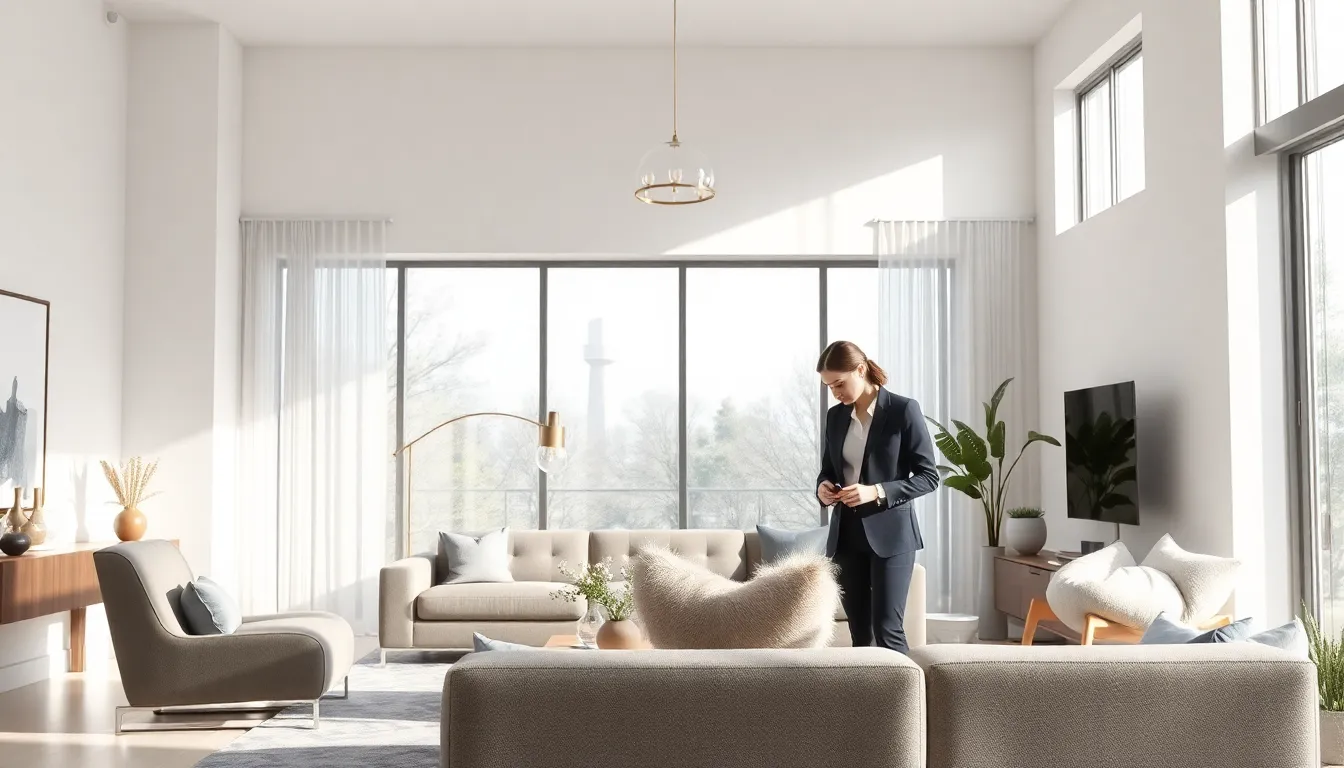Table of Contents
ToggleIn the world of interior design, lines are more than just straight edges or curves; they’re the invisible threads weaving together the fabric of a space. Think of lines as the secret handshakes of design—subtle yet powerful, guiding the eye and setting the mood. Whether it’s the sleek lines of modern furniture or the whimsical curves of a vintage lamp, they define how a room feels and functions.
Imagine walking into a room where the lines are all over the place—it’s like trying to dance at a wedding with a three-legged chair. Not exactly graceful, right? Understanding line definition helps designers create harmony and balance, transforming mere walls into a stunning visual symphony. So, buckle up as we dive into the fascinating world of lines in interior design, where creativity meets structure and every angle tells a story.
Line Definition in Interior Design
Line definition in interior design refers to the way lines contribute to a space’s layout and character. Straight lines create a sense of order and organization, essential for minimalist designs. Curved lines introduce softness and movement, often making a room feel more inviting and comfortable.
Vertical lines can elevate a room, drawing the eye upward and enhancing the perception of height. Horizontal lines evoke stability and calmness, providing a grounding effect. Diagonal lines add dynamism and interest, directing attention to focal points in a room.
Different line types can interact to create various visual agreements. For example, a combination of straight and curved lines can juxtapose structure and softness, enriching the overall design. Rooms designed with balanced lines can foster harmony and cohesion.
Incorporating line elements involves various aspects, including furniture arrangement, architectural features, and decorative accents. A well-placed piece of artwork or window treatment can reinforce the intended line definition, enhancing the space’s flow.
Understanding the role of lines can drastically improve design outcomes. Designers often analyze how lines influence movement, which can affect how individuals navigate a room. Effective line definition not only determines visual appeal but also impacts functionality.
Ultimately, lines serve as foundational components that dictate the essence of interior spaces. Recognizing this helps designers create environments that resonate with the intended mood and purpose.
Importance of Line in Interior Design

Lines in interior design offer significant visual cues that shape a space’s overall feel. Different types of lines enhance the aesthetic appeal and functionality of a room.
Visual Impact of Lines
Straight lines generate a clean and modern look, drawing the eye along surfaces and enhancing organization. Curved lines, on the other hand, instill a sense of movement and tranquility, encouraging a welcoming environment. Vertical lines stretch upward, making spaces feel larger, while horizontal lines ground a room, providing stability. The dynamic nature of diagonal lines introduces a sense of energy and action. These varying effects can dramatically transform perceptions of a space, guiding attention and influencing emotions.
Creating Balance and Harmony
Balance relies heavily on the effective use of lines. Linear elements, when distributed evenly, foster a sense of symmetry and order within a design. Curved lines can soften sharper angles, uniting contrasting elements for a cohesive look. Designers often use line definition to promote harmony, ensuring that no single aspect overwhelms the others. Through strategic arrangements, lines can connect different features, creating a unified flow that enhances usability and aesthetics. Thoughtful line integration allows spaces to reflect a tranquil, harmonious atmosphere.
Types of Lines in Interior Design
Lines in interior design come in several varieties, each with its own distinctive impact on a space’s ambiance and functionality.
Straight Lines
Straight lines evoke a sense of order in a room. They guide the eye, creating a clean and modern aesthetic. Commonly seen in furniture and architectural features, these lines enhance structure. Designers often use straight lines to project stability and control within a space. For example, rectangular tables and linear shelving units exhibit this principle. Rooms with an abundance of straight lines often feel organized, calming, and purposeful.
Curved Lines
Curved lines introduce softness and flow to a room’s design. Unlike straight lines, these gentle forms invite movement, making a space more welcoming. Curved sofas or round coffee tables exemplify this approach. They create visual interest and contrast against harsher angles, fostering harmony. Designers frequently incorporate curves to balance sharp edges, promoting relaxation and comfort. This balance enhances the overall dynamic, making rooms feel inviting and pleasantly approachable.
Diagonal Lines
Diagonal lines impart energy and dynamism to interior spaces. They’re less common but highly effective when used strategically. These lines can be noticed in slanted ceilings or angled furniture placements. Such elements create a sense of movement and encourage exploration within a room. By introducing unexpected angles, designers can elevate a space’s atmosphere, making it feel more vibrant and alive. Creating focal points through diagonal lines can also lead to dramatic visual impact, enhancing overall engagement within the design.
Applications of Line in Interior Design
Lines play an essential role in various aspects of interior design, influencing everything from furniture arrangement to decorative elements and architectural features.
Furniture Arrangement
Effective furniture arrangement relies on line definitions to create flow and functionality. Straight lines often dominate layouts, promoting organization and clarity in a space. Curved lines can soften furniture arrangements, encouraging conversation and movement. Diagonal lines introduce visual interest, leading the eye through different zones. Each line type serves a purpose; straight lines lend stability, while curves invite comfort. Designers carefully consider these lines to optimize both aesthetics and usability, ensuring that a room feels connected and balanced.
Architectural Features
Architectural features benefit significantly from line applications. Vertical lines in beams and columns enhance the perception of height, making spaces feel more open and airy. Straight lines in door frames and window placements create a sense of order, contributing to a cohesive design. Curved elements, such as arches or rounded walls, soften the overall appearance, adding elegance and fluidity. Diagonal lines in structural components can add dynamism, breaking up monotony and drawing attention to key areas. Each line enhances the architectural character of a space, highlighting design intentions and improving functionality.
Decorative Elements
Decorative elements also utilize line definitions for visual appeal. Artwork, patterns, and textiles incorporate lines that direct focus and create harmony. Straight lines in frames promote structure, while curves in fabrics and accessories provide softness and warmth. Diagonal lines in decorative arrangements instill energy, encouraging exploration of the space. Each style of line contributes to the overall atmosphere, shaping how occupants interact with their environment. Strategic use of lines in decorative elements ensures an inviting and engaging interior, appealing to both aesthetics and comfort.
Understanding line definition in interior design is essential for creating spaces that are both visually appealing and functional. By skillfully combining straight, curved, and diagonal lines, designers can evoke specific feelings and enhance the overall atmosphere of a room. The thoughtful arrangement of these lines fosters balance and harmony, making a space feel cohesive and inviting.
As designers explore the interplay of lines, they unlock the potential to transform ordinary spaces into extraordinary environments. Ultimately, mastering line definition empowers designers to craft interiors that resonate with the desired mood and purpose, ensuring that every element contributes to the overall experience.







